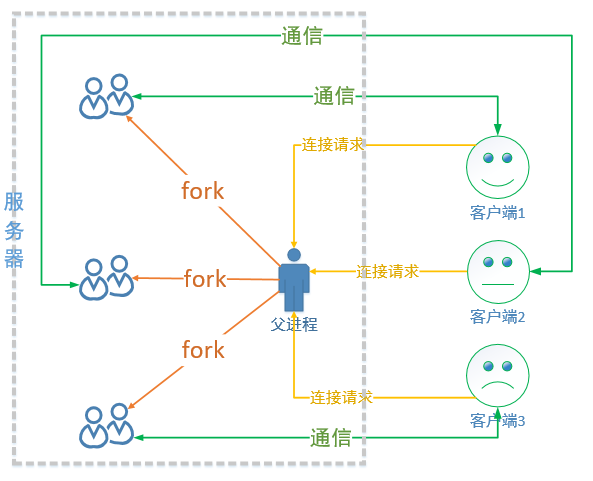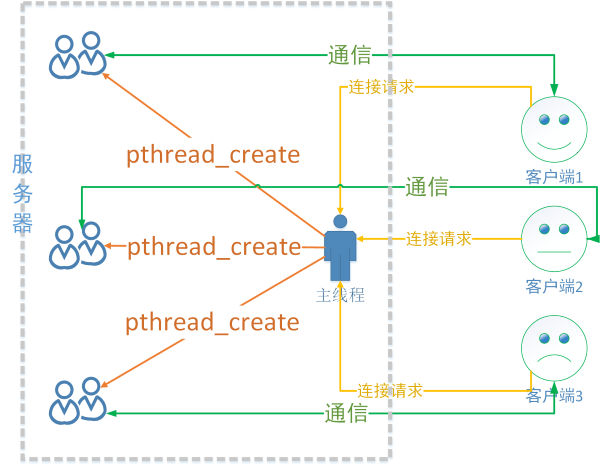单进程/线程 TCP 通信过程中,服务器端启动之后可以同时和多个客户端建立连接,并进行网络通信。
1 2 3 4 5 6 7 8 9 10 11 12 13 14 15 16 17 18 19 20 21 22 23 24 25 26 27 28 29 30 31 32 33 34 35 36 37 38 39 40 41 42 43 44 45 46 47 48 49 50 51 52 53 54 55 56 57 58 #include <stdio.h> #include <stdlib.h> #include <unistd.h> #include <string.h> #include <arpa/inet.h> int main () int lfd = socket (AF_INET, SOCK_STREAM, 0 );struct sockaddr_in addr;htons (10000 ); int ret = bind (lfd, (struct sockaddr*) &addr, sizeof (addr));listen (lfd, 128 );struct sockaddr_in caddr;int clen = sizeof (caddr);int cfd = accept (lfd, (struct sockaddr*) &caddr, &clen);while (1 )char buf[1024 ];memset (buf, 0 , sizeof (buf));int len = read (cfd, buf, sizeof (buf));if (len > 0 )printf ("read client data: %s\n" , buf);write (cfd, buf, len);else if (len == 0 )printf ("client closed...\n" );break ;else perror ("read" );break ;close (cfd);close (lfd);return 0 ;
在上面的代码中用到了三个会引起程序阻塞 的函数,分别是:accept():如果服务器端没有新的客户端连接,阻塞当前进程/线程;如果检测到新的连接,解除阻塞、建立连接。read():如果通信的套接字对应的读缓冲区没有数据,阻塞当前进程/线程;如果检测到数据,解除阻塞、接收数据。write():如果通信的套接字写缓冲区被写满,阻塞当前进程/线程(这种情况比较少见)
如果需要和发起新的连接请求的客户端建立连接,那么就必须在服务器端通过一个循环调用 accept() 函数,accept() 阻塞就无法通信,被 read() 阻塞就无法和客户端建立新连接。
1 2 3 4 使用多进程实现IO 多路转接(复用)实现IO 多路转接 + 多线程实现
多进程并发 如果要编写多进程的并发服务器程序,首先要考虑,创建出的多个进程都是什么角色,在 Tcp 服务器端一共有两个角色,分别是:监听和通信。
父进程:accept() 函数
在多进程版的服务器端程序中,多个进程是有血缘关系。
多进程版并发 TCP 服务器,示例代码:
1 2 3 4 5 6 7 8 9 10 11 12 13 14 15 16 17 18 19 20 21 22 23 24 25 26 27 28 29 30 31 32 33 34 35 36 37 38 39 40 41 42 43 44 45 46 47 48 49 50 51 52 53 54 55 56 57 58 59 60 61 62 63 64 65 66 67 68 69 70 71 72 73 74 75 76 77 78 79 80 81 82 83 84 85 86 87 88 89 90 91 92 93 94 95 96 97 98 99 100 101 102 103 104 105 106 107 108 109 110 111 112 113 114 115 116 117 118 119 120 121 122 123 124 125 126 127 128 129 130 131 132 133 134 135 136 137 138 139 140 141 142 143 144 145 #include <stdio.h> #include <stdlib.h> #include <string.h> #include <unistd.h> #include <arpa/inet.h> #include <signal.h> #include <sys/wait.h> #include <errno.h> void callback (int num) while (1 )pid_t pid = waitpid (-1 , NULL , WNOHANG);if (pid <= 0 )printf ("child process is running, or is waited\n" );break ;printf ("child process, pid = %d\n" , pid);int childWork (int cfd) int main () int lfd = socket (AF_INET, SOCK_STREAM, 0 );if (lfd == -1 )perror ("socket" );exit (0 );struct sockaddr_in addr;htons (10000 ); int ret = bind (lfd, (struct sockaddr*) &addr, sizeof (addr));if (ret == -1 )perror ("bind" );exit (0 );listen (lfd, 128 );if (ret == -1 )perror ("listen" );exit (0 );struct sigaction act;0 ;sigemptyset (&act.sa_mask);sigaction (SIGCHLD, &act, NULL );while (1 )struct sockaddr_in cliaddr;int clilen = sizeof (cliaddr);int cfd = accept (lfd, (struct sockaddr*)&cliaddr, &clilen);if (cfd == -1 )if (errno == EINTR)continue ;perror ("accept" );exit (0 );char ip[24 ] = {0 };printf ("client ip: %s, port: %d\n" ,inet_ntop (AF_INET, &cliaddr.sin_addr.s_addr, ip, sizeof (ip)),ntohs (cliaddr.sin_port));pid_t pid = fork();if (pid == 0 )close (lfd);while (1 )int ret = childWork (cfd);if (ret <=0 )break ;close (cfd);exit (0 );else if (pid > 0 )close (cfd);return 0 ;int childWork (int cfd) char buf[1024 ];memset (buf, 0 , sizeof (buf));int len = read (cfd, buf, sizeof (buf));if (len > 0 )printf ("read client data: %s\n" , buf);write (cfd, buf, len);else if (len == 0 )printf ("client closed...\n" );else perror ("read" );return len;
上面的示例代码中,父子进程中分别关掉了用不到的文件描述符(父进程不需要通信,子进程也不需要监听)。sigaction() 函数捕捉了该信号,通过回调函数 callback()中的 waitpid() 对退出的子进程进行了资源回收。
多线程并发 编写多线程版的并发服务器程序和多进程思路差不多。
主线程:accept() 函数accept(),直接做线程分离。
在多线程版的服务器端程序中,多个线程共用同一个地址空间,有些数据是共享的,有些数据的独占的,下面来分析一些细节:
示例代码:
1 2 3 4 5 6 7 8 9 10 11 12 13 14 15 16 17 18 19 20 21 22 23 24 25 26 27 28 29 30 31 32 33 34 35 36 37 38 39 40 41 42 43 44 45 46 47 48 49 50 51 52 53 54 55 56 57 58 59 60 61 62 63 64 65 66 67 68 69 70 71 72 73 74 75 76 77 78 79 80 81 82 83 84 85 86 87 88 89 90 91 92 93 94 95 96 97 98 99 100 101 102 103 104 105 106 107 108 109 110 111 112 113 114 115 116 117 118 119 120 121 122 123 124 125 126 127 128 129 130 131 132 133 134 135 136 137 138 #include <stdio.h> #include <stdlib.h> #include <string.h> #include <unistd.h> #include <arpa/inet.h> #include <pthread.h> struct SockInfo int fd; pthread_t tid; struct sockaddr_in addr; struct SockInfo infos[128 ];void * working (void * arg) struct SockInfo * pinfo = (struct SockInfo*)arg;char ip[32 ];inet_ntop (AF_INET, &pinfo->addr.sin_addr.s_addr, ip, sizeof (ip));unsigned short port = ntohs (pinfo->addr.sin_port);printf ("client ip: %s, port: %d\n" , ip, port);while (1 ) char buf[1024 ];memset (buf, 0 , sizeof (buf));int len = read (pinfo->fd, buf, sizeof (buf));if (len > 0 )printf ("read client data : %s\n" , buf);write (pinfo->fd, buf, strlen (buf));else if (len == 0 )printf ("client closed...\n" );-1 ;break ;else perror ("read" );-1 ;exit (-1 );return NULL ;int main () int fd = socket (AF_INET, SOCK_STREAM, 0 );if (fd == -1 )perror ("socket" );exit (-1 );struct sockaddr_in saddr;htons (9999 );int ret = bind (fd, (struct sockaddr*) &saddr, sizeof (saddr));if (ret == -1 )perror ("bind" );exit (-1 );listen (fd, 128 );if (ret == -1 )perror ("listen" );exit (-1 );int max = sizeof (infos) / sizeof (infos[0 ]);for (int i = 0 ; i < max; ++i)bzero (&infos[i], sizeof (infos[i]));-1 ;-1 ;int addrlen = sizeof (struct sockaddr_in);while (1 )struct SockInfo * pinfo;for (int i = 0 ; i < max; ++i)if (infos[i].fd == -1 )break ;if (i == max - 1 )sleep (1 );int cfd = accept (fd, (struct sockaddr*) &pinfo->addr, &addrlen);printf ("parent thread, cfd: %d\n" , cfd);if (cfd == -1 )perror ("accept" );break ;pthread_create (&pinfo->tid, NULL , working, pinfo);pthread_detach (pinfo->tid);close (fd);return 0 ;
基于线程池 1 2 3 4 5 6 7 8 9 10 11 12 13 14 15 16 17 18 19 20 21 22 23 24 25 26 27 28 29 30 31 32 33 34 35 36 37 38 39 40 41 42 43 44 45 46 47 48 49 50 51 52 53 54 55 56 57 58 59 60 61 62 63 64 65 66 67 68 69 70 71 72 73 74 75 76 77 78 79 80 81 82 83 84 85 86 87 88 89 90 91 92 93 94 95 96 97 98 99 100 101 102 103 104 105 106 107 108 109 110 111 112 113 114 115 116 117 118 119 120 121 122 123 124 125 126 127 128 129 130 131 132 133 #include <stdio.h> #include <stdlib.h> #include <string.h> #include <unistd.h> #include <arpa/inet.h> #include <pthread.h> #include "threadpool.h" struct SockInfo int fd; pthread_t tid; struct sockaddr_in addr; typedef struct PoolInfo int fd; void working (void * arg) void acceptConn (void * arg) int main () int fd = socket (AF_INET, SOCK_STREAM, 0 );if (fd == -1 )perror ("socket" );exit (-1 );struct sockaddr_in saddr;htons (9999 );int ret = bind (fd, (struct sockaddr*) &saddr, sizeof (saddr));if (ret == -1 )perror ("bind" );exit (-1 );listen (fd, 128 );if (ret == -1 )perror ("listen" );exit (-1 );threadPoolCreate (3 , 8 , 100 );malloc (sizeof (PoolInfo));threadPoolAdd (pool, acceptConn, info);pthread_exit (NULL );return 0 ;void acceptConn (void * arg) int addrlen = sizeof (struct sockaddr_in);while (1 )struct SockInfo * pinfo;struct SockInfo*)malloc (sizeof (struct SockInfo));accept (poolInfo->fd, (struct sockaddr*) &pinfo->addr, &addrlen);if (pinfo->fd == -1 )perror ("accept" );break ;threadPoolAdd (poolInfo->pool, working, pinfo);close (poolInfo->fd);void working (void * arg) struct SockInfo * pinfo = (struct SockInfo*)arg;char ip[32 ];inet_ntop (AF_INET, &pinfo->addr.sin_addr.s_addr, ip, sizeof (ip));unsigned short port = ntohs (pinfo->addr.sin_port);printf ("client ip: %s, port: %d\n" , ip, port);while (1 ) char buf[1024 ];memset (buf, 0 , sizeof (buf));int len = read (pinfo->fd, buf, sizeof (buf));if (len > 0 )printf ("read client data : %s\n" , buf);write (pinfo->fd, buf, strlen (buf));else if (len == 0 )printf ("client closed...\n" );-1 ;break ;else perror ("read" );-1 ;exit (-1 );close (pinfo->fd);
参考资料 https://subingwen.cn/linux/concurrence

